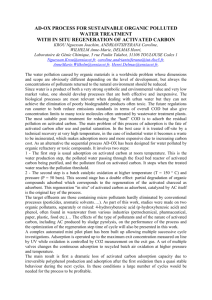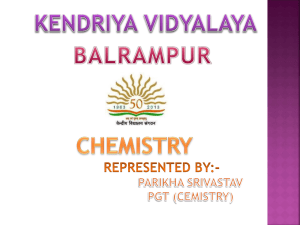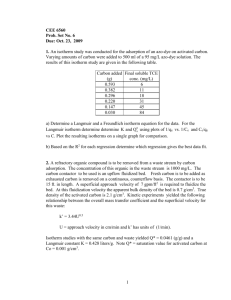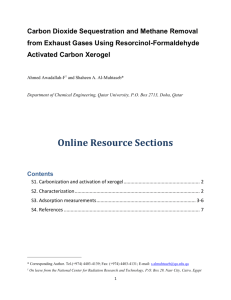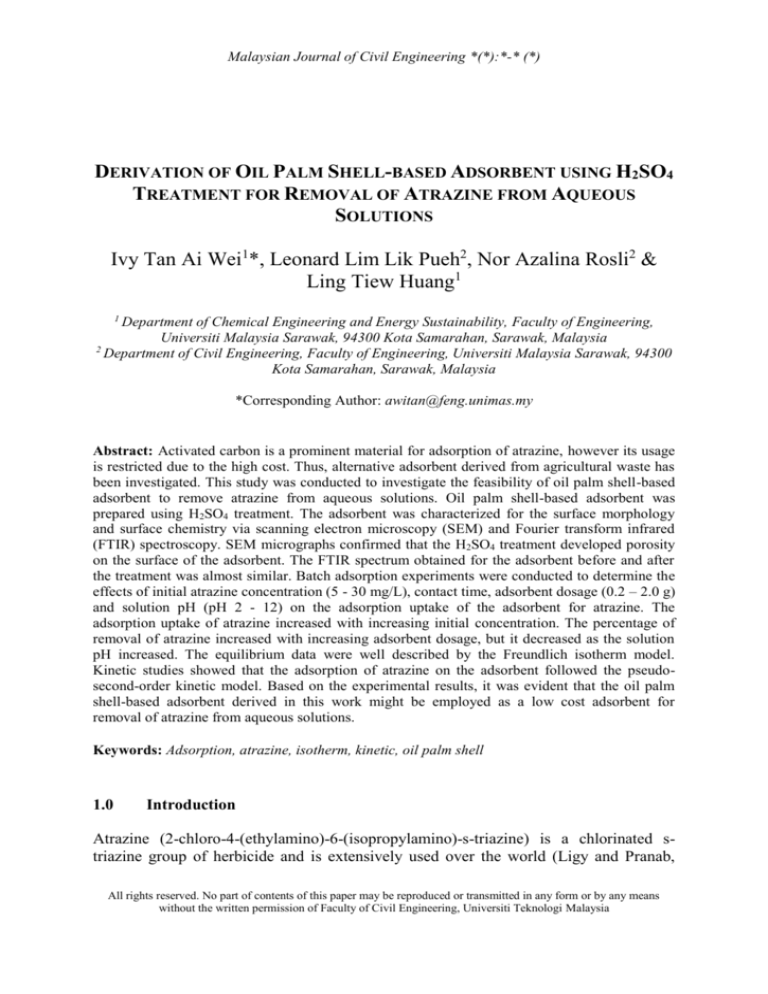
Malaysian Journal of Civil Engineering *(*):*-* (*)
DERIVATION OF OIL PALM SHELL-BASED ADSORBENT USING H2SO4
TREATMENT FOR REMOVAL OF ATRAZINE FROM AQUEOUS
SOLUTIONS
Ivy Tan Ai Wei1*, Leonard Lim Lik Pueh2, Nor Azalina Rosli2 &
Ling Tiew Huang1
1
Department of Chemical Engineering and Energy Sustainability, Faculty of Engineering,
Universiti Malaysia Sarawak, 94300 Kota Samarahan, Sarawak, Malaysia
2
Department of Civil Engineering, Faculty of Engineering, Universiti Malaysia Sarawak, 94300
Kota Samarahan, Sarawak, Malaysia
*Corresponding Author: awitan@feng.unimas.my
Abstract: Activated carbon is a prominent material for adsorption of atrazine, however its usage
is restricted due to the high cost. Thus, alternative adsorbent derived from agricultural waste has
been investigated. This study was conducted to investigate the feasibility of oil palm shell-based
adsorbent to remove atrazine from aqueous solutions. Oil palm shell-based adsorbent was
prepared using H2SO4 treatment. The adsorbent was characterized for the surface morphology
and surface chemistry via scanning electron microscopy (SEM) and Fourier transform infrared
(FTIR) spectroscopy. SEM micrographs confirmed that the H2SO4 treatment developed porosity
on the surface of the adsorbent. The FTIR spectrum obtained for the adsorbent before and after
the treatment was almost similar. Batch adsorption experiments were conducted to determine the
effects of initial atrazine concentration (5 - 30 mg/L), contact time, adsorbent dosage (0.2 – 2.0 g)
and solution pH (pH 2 - 12) on the adsorption uptake of the adsorbent for atrazine. The
adsorption uptake of atrazine increased with increasing initial concentration. The percentage of
removal of atrazine increased with increasing adsorbent dosage, but it decreased as the solution
pH increased. The equilibrium data were well described by the Freundlich isotherm model.
Kinetic studies showed that the adsorption of atrazine on the adsorbent followed the pseudosecond-order kinetic model. Based on the experimental results, it was evident that the oil palm
shell-based adsorbent derived in this work might be employed as a low cost adsorbent for
removal of atrazine from aqueous solutions.
Keywords: Adsorption, atrazine, isotherm, kinetic, oil palm shell
1.0
Introduction
Atrazine (2-chloro-4-(ethylamino)-6-(isopropylamino)-s-triazine) is a chlorinated striazine group of herbicide and is extensively used over the world (Ligy and Pranab,
All rights reserved. No part of contents of this paper may be reproduced or transmitted in any form or by any means
without the written permission of Faculty of Civil Engineering, Universiti Teknologi Malaysia
2
Malaysian Journal of Civil Engineering *(*):*-* (*)
2006). Atrazine is used extensively as a pre- and post-emergent treatment to control
broadleaf and grassy weeds on both agricultural and non-agricultural land (Jamil et al.,
2011; Mudhoo and Garg, 2011). However, agricultural use of pesticides negatively
impacts water quality and poses environmental pollution, even though its use is in a
limited amount of compound (Aydinalp and Porca, 2004). Adsorption technique is
favourable for atrazine removal due to its simplicity as well as the availability of a wide
range of adsorbents. Commercial activated carbon has high adsorption capacity for
removal of atrazine. However, the major drawback is its high cost of production, making
its usage in removal of atrazine less attractive. Thus, there is a demand for alternative
adsorbents, which are of inexpensive materials such as agricultural wastes. Since oil
palm shell is abundant in Malaysia, therefore this study aims to investigate the
feasibility of oil palm shell-based low cost adsorbent for removal of atrazine from
aqueous solutions.
2.0
Materials and Methods
2.1
Materials
Analytical grade standard of atrazine was used for preparation of stock solution.
Analytical grade standard of methanol was used for UV-Visible spectrophotometry
analysis of atrazine concentration. Double distilled water was used for purifying
adsorbent material and preparing solution samples. Oil palm shell obtained from
FELCRA, Kota Samarahan division was selected as raw material to prepare the
adsorbent. Oil palm shell granular activated carbon (6 x 12 mesh size) obtained from
Bravo Green Sdn. Bhd. was used for comparison with the adsorbent developed for the
adsorption studies.
2.2
Preparation of Adsorbent
The oil palm shell was washed with double distilled water to remove foreign impurities
and the sample was then dried in oven at 50 oC for 48 h. The washed and dried material
was ground and sieved to particle size of 0.15 - 0.30 mm. The fibres attached to the
surface of oil palm shell were then removed. 300 g of the sieved oil palm shell was
soaked in 400 mL of n-hexane to remove oil from the surface of the oil palm shell. The
sample was then washed thoroughly with double distilled water and dried in oven at 110
o
C for 12 h. The sample was then soaked in 400 mL of 0.1 M sulphuric acid (H2SO4) for
4 h at 30 oC. After the H2SO4 treatment, the adsorbent was washed with hot double
distilled water until pH 7 to remove residue H2SO4 and was then dried in oven at 110 oC
for 12 h. The dried adsorbents were cooled to room temperature and were stored in airtight container for further characterization and adsorption studies.
3
Malaysian Journal of Civil Engineering *(*):*-* (*)
2.3
Charaterisation of Adsorbent
The surface morphology of the oil palm shell and oil palm shell-based adsorbent were
analyzed by using a scanning electron microscope (Model JEOL JSM-6390LA). The
Fourier transform infrared (FTIR) spectroscopy analysis was conducted using FTIR
spectrophotometer (Model Shimadzu IRAffinity-1) in the range of 400-4000 cm-1
wavelength with 4 cm−1 resolution. FTIR characterization was used to determine the
functional groups present on the surface of the samples.
2.4
Batch Adsorption Studies
Stock solution of atrazine of 30 mg/L was prepared by dissolving 30 mg of atrazine in
10 mL of methanol initially in 1000 mL volumetric flask. The solutions were then made
up to the volume with double distilled water. Stock solution of atrazine was initially
dissolved in a small quantity of methanol in order to accelerate its dissolution in water.
The stock solution was then diluted using double distilled water to the desired
concentration in the range of 5-30 mg/L. Adsorption studies of atrazine on the oil palm
shell-derived adsorbent were carried out in batch mode. Adsorption experiments to
study the effect of initial concentration were carried out by contacting 0.2 g of adsorbent
with 200 mL of atrazine solution of different concentrations: 5, 10, 15, 20, 25 and 30
mg/L at constant temperature (30 oC) in 250 mL Erlenmeyer flasks. The effect of initial
concentration was then evaluated on activated carbon for comparison. The effect of
adsorbent dosage on the adsorption of atrazine on oil palm shell-based adsorbent was
studied by contacting 200 mL of atrazine solution at fixed concentration of 30 mg/L
with various adsorbent dosages of 0.2, 0.4, 0.8, 1.2, 1.6 and 2.0 g at 30 oC in 250 mL
Erlenmeyer flasks. Meanwhile, the effect of pH on atrazine adsorption was investigated
by contacting 0.2 g of adsorbent with 200 mL of atrazine solution with fixed
concentration (5 mg/L) at varying initial solution pH (2-12) at 30 oC.
The absorbance of atrazine at maximum wavelength of 222 nm was plotted against
atrazine concentration to obtain a calibration curve for determination of atrazine
concentration in this study. The adsorption uptake at time t, qt (mg/g), was expressed by
Eq. 1:
qt = (Co- Ct )V/W
(1)
where qt is the amount of atrazine adsorbed by adsorbent (mg/g), Co is the initial liquidphase concentrations of atrazine (mg/L), Ct is the liquid-phase concentration of atrazine
at any time t (mg/L) , V is the solution volume (L), and W is the mass of adsorbent used
(g).
4
2.5
Malaysian Journal of Civil Engineering *(*):*-* (*)
Adsorption Isotherms
Langmuir and Freundlich isotherm models were employed to fit the equilibrium data to
evaluate the equilibrium between adsorbate and adsorbent of the adsorption process.
Langmuir isotherm is mainly employed to monolayer adsorption on perfectly smooth
and homogeneous surface. The linear form of the Langmuir (Langmuir, 1918)
adsorption isotherm equation (Eq. 2) can be expressed as:
Ce/qe = 1/QmKL + (1/Qm) Ce
(2)
where Ce is the equilibrium concentration of the adsorbate (mg/L), qe is the amount of
adsorbate adsorbed per unit mass of adsorbent (mg/g), Q m and KL are Langmuir
constants related to adsorption capacity (mg/g) and rate of adsorption (L/mg),
respectively. The plot of Ce/qe against Ce would give the value of Qm and KL.
Freundlich isotherm is extensively applied for adsorption surfaces with non-uniform
energy distribution. The linear form of the Freundlich (Freundlich, 1906) adsorption
isotherm equation (Eq. 3) can be expressed as:
ln qe = ln KF + (1/n) ln Ce
(3)
where KF and n are Freundlich constants which KF is the adsorption capacity of the
adsorbent (mg/g)(L/mg)1/n and n is a measure of favourability of the adsorption process.
The plot of ln qe against ln Ce would give the value of KF and n.
2.6
Adsorption Kinetics
The kinetics data obtained were fitted to pseudo-first-order and pseudo-second-order
kinetic models to determine the adsorption mechanism. The pseudo-first-order (Eq. 4)
(Kannan and Sundaram, 2001) and pseudo-second-order (Eq. 5) (Yang and Al-Duri,
2005) equations can be expressed as:
ln (qe – qt) = ln qe – k1t
(4)
where qe and qt are the amounts of adsorbate adsorbed (mg/g) at equilibrium and at time
t, respectively, and k1 is the adsorption rate constant (min-1). Constant k1 and qe could be
calculated from the plot of ln (qe – qt) versus time t.
t/qt = 1/k2 qe2 + (1/qe) t
(5)
where k2 is the rate constant of second-order adsorption (g/mg min). The plot of t/qt
against t would give the value of k2 and qe.
Malaysian Journal of Civil Engineering *(*):*-* (*)
3.0
Results and Discussion
3.1
Characterisation of Adsorbent
5
The SEM micrographs of the raw oil palm shell, oil palm shell-based adsorbent treated
with H2SO4, activated carbon and oil palm shell-based adsorbent after adsorption of
atrazine are presented in Figures 1(a), (b), (c) and (d), respectively. From Figure 1(a),
the SEM micrograph shows dirt-covered and unclear pores on the surface of raw oil
palm shell. There were very small pores present on the surface of the raw oil palm shell.
Chemical activation with H2SO4 on the oil palm shell-based adsorbent resulted in the
development of pores, as shown in Figure 1(b). However, the pores developed were not
deep enough for high adsorption of atrazine. Meanwhile, the pores found on the surface
of the activated carbon were relatively larger. It could be seen that the external surface
of activated carbon was full of clear and deep pores, as illustrated in Figure 1(c). Owing
to these well-developed pores, the activated carbon possessed higher surface area and
adsorptive capacity (Guo and Lua, 1998). From Figure 1(d), it could be observed that
there were some atrazine molecules adsorbed on the surface of the oil palm shell-based
adsorbent. However, the pores developed on the surface of the adsorbent were slightly
being occupied by the atrazine molecules.
(a)
(b)
(c)
(d)
Figure 1: SEM micrographs (3000 x magnification) of (a) Rraw oil palm shell, (b) Oil palm
shell-based adsorbent treated with H2SO4, (c) Activated carbon and (d) Oil palm shell-based
adsorbent after adsorption of atrazine
6
Malaysian Journal of Civil Engineering *(*):*-* (*)
From the FTIR spectrum obtained (data not shown), the presence of chemisorbed water
and surface hydroxylic groups in raw oil palm shell was indicated by the absorbance
peak of O-H stretching vibration between 3450 and 4000 cm-1 (Yacob et al., 2008). A
weak absorbance peak was observed at 2885.51 cm-1 corresponding to the C–H sp3
stretching (Yacob et al., 2008). The C=C stretching vibration of alkynes group was
indicated by the absorbance peak between 2200 – 1950 cm-1, indicating the presence of
ketones (Guo and Lua, 2002). The strong broad absorbance peak between 1780 – 1640
cm-1 represented the C=O stretching vibration which indicated the presence of quinones
(Guo and Lua, 2002). The very strong absorbance peaks at 1525.69 cm-1 and 1024.20
cm-1 were attributed to C=C stretching vibration of aromatic rings and O-H deformation
vibration, respectively (Guo and Lua, 2002). The absorbance peak at 1247.94 cm-1
represented the stretching vibration of C–O functional group, indicating the presence of
carboxylic acids (Guo and Lua, 1998; Yacob et al., 2008). Although the adsorbent was
prepared through chemical treatment, it exhibited similarity in the FTIR spectrum with
that of raw oil palm shell. This indicated that the chemical treatment with H2SO4
increased the porosity of adsorbent without changing the surface chemistry. However,
the absorbance peaks at 1247.94 cm-1 and 1024.20 cm-1 which were assigned to C-O
carboxylic acid had been eliminated due to that the sample was washed thoroughly with
hot double distilled water to remove any remaining H2SO4. Lower intensity observed at
the absorbance peaks between 2200 – 1950 cm-1 could be attributed to the reaction
between the sulfuric acid and the oil palm shell. Moreover, the FTIR spectrum of
activated carbon also exhibited similar trend as the oil palm shell-based adsorbent.
3.2
Effect of Contact Time and Initial Atrazine Concentration
The effect of contact time and initial atrazine concentration on adsorption of atrazine on
oil palm shell-based adsorbent and activated carbon are shown in Figures 2 and 3,
respectively. Batch adsorption experiments were carried out for 24 h to attain
equilibrium. Figure 2 shows that the contact time necessary for adsorption of atrazine on
oil palm shell-based adsorbent to reach equilibrium ranged between 150 to 240 min.
However, for adsorption of atrazine on activated carbon, longer contact time of 24 h was
required to achieve adsorption equilibrium, as shown in Figure 3. It could be seen that
the adsorption rate at different concentrations was rapid in the first 15 min and steadily
decreased with time until it gradually approached a plateau. The initial rapid uptake
could be attributed to the availability of the number of free adsorption sites on the
adsorbent and the higher concentration gradient created at the beginning of the
adsorption process (Alam et al., 2004). As the atrazine loading on the adsorbent
increased, the concentration gradient reduced and gave way to a much slower uptake.
Furthermore, the atrazine uptake, qt increased with increasing in initial atrazine
concentration. The amount of atrazine uptake at equilibrium, qe increased from 0.168 to
3.378 mg/g for oil palm shell-based adsorbent and from 5.392 to 30.734 mg/g for
activated carbon, with the increase in the initial atrazine concentrations from 5 to 30
mg/L. The initial concentration provided an important driving force to overcome all
Malaysian Journal of Civil Engineering *(*):*-* (*)
7
mass transfer resistances of the atrazine between the aqueous and solid phases. Hence, a
higher initial concentration of atrazine would enhance the adsorption process.
Furthermore, the adsorption of atrazine could be described by three consecutive mass
transport steps (Alam et al., 2007). Firstly, the adsorbate transferred through the solution
to the adsorbent exterior surface, followed by adsorbate diffusion into the pores of
adsorbent. Finally, the adsorbate was adsorbed into the active sites at the interior of the
adsorbent particle. Thus, activated carbon showed a much better adsorption performance
than oil palm shell-based adsorbent, which could be attributed to the higher porosity in
activated carbon.
3.3
Effect of Adsorbent Dosage
Figure 4 shows the removal percentage of atrazine as a function of adsorbent dosage.
The removal percentage of atrazine increased from 9.35 to 14.34 % with increasing
adsorbent dosage from 0.2 to 2.0 g. This was due to the increase in the number of
adsorption sites (Selvaraj et al., 1997; Sharma and Forster, 1993). Gupta et al. (2011)
reported similar trend in the study of pesticides (methoxychlor, atrazine and methyl
parathion) removal from waste water on activated carbon prepared from waster rubber
tire. It was reported that the increase in adsorbent dosage from 0.2 to 1.6 g resulted in a
significant increase in removal percentage of atrazine probably due to a stronger driving
force and larger surface area (Gupta et al., 2011). Any further increment of the
adsorbent did not pose any noticeable change in the removal percentage, which might be
due to overlapping of adsorption sites as a result of overcrowding of adsorbent particles
(Namasivayam et al., 1998).
Figure 2: Time variation of adsorption of
atrazine on oil palm shell-based adsorbent at
various initial concentrations
Figure 3: Time variation of adsorption of
atrazine on activated carbon at various initial
concentrations
8
Malaysian Journal of Civil Engineering *(*):*-* (*)
Figure 4: Removal percentage of atrazine on
oil palm shell-based adsorbent at different
adsorbent dosage
3.4
Figure 5: Removal percentage of atrazine on
oil palm shell-based adsorbent at different
solution pH
Effect of Solution pH
Figure 5 shows the effect of solution pH on the removal percentage of atrazine on the oil
palm shell-based adsorbent. The removal percentage of atrazine decreased from 12.79 to
1.41 % with an increase in the solution pH from 2 to 12. Similar trends had been
reported for the adsorption of atrazine (Rafique and Nasreen, 2011), prometryn (Topp et
al., 1997), imazaqun and imazethapyr (Barriuso et al., 1992). As the solution pH
increased, the functional groups especially carbonyl and hydroxyl groups became
deprotonated, thus leading to development of negative charge at the surface of adsorbent
(Gupta et al., 2011). At higher pH, a more negatively charged surface of the adsorbent
posed stronger electrostatic repulsion for atrazine molecules and thereby decreased the
adsorption of atrazine. However, with a decrease in solution pH, the adsorption of
atrazine on oil palm shell-based adsorbent increased due to weaker electrostatic
repulsion as a result of the reduction in degree of deprotonation (Gupta and Imran,
2008). Besides, atrazine is a weak basic herbicide with pKa value of 1.68. Atrazine could
be adsorbed on adsorbent as both protonated and neutral species, depending on the
solution pH (Weber, 1970). As the pH values were close to pKa value, atrazine
experienced protonization in acidic solutions which favoured hydrogen bond formation
or proton transfer, thus resulting in the increase of removal percentage of atrazine
(Rafique and Nasreen, 2011). However, atrazine is found as neutral molecule in the
environment (pH ≈ 5 to 8) (Colombini et al., 1998). Meanwhile, with the increasing of
solution pH, weakly basic atrazine became molecular species (Jamil et al., 2011). At
higher solution pH, a more negative charge developed at the surface of adsorbent and
posed a stronger electrostatic repulsion for atrazine molecules, thus resulted in decrease
in adsorption of atrazine (Gupta et al., 2011).
Malaysian Journal of Civil Engineering *(*):*-* (*)
3.5
9
Adsorption Isotherms
The Langmuir equation is applicable to homogeneous adsorption where the adsorption
of each adsorbate molecule on to the surface has equal adsorption activation energy.
When Ce/qe was plotted against Ce, a straight line with slope of 1/Qm was obtained. The
values of Qm and KL were determined from the Langmuir plots and are presented in
Table 1. The adsorption data of atrazine on both oil palm shell-based adsorbent and
activated carbon were not fitted well into Langmuir isotherm as the correlation
coefficients, R2 obtained were relatively low. Furthermore, the negative values of
Langmuir constants for oil palm shell-based adsorbent indicated the inadequacy of
Langmuir isotherm to describe the adsorption of atrazine on the adsorbent (Uçar et al.,
2011). Unlike Langmuir isotherm model, Freundlich model occupies heterogeneous
adsorption surface and active sites with different energy (Djebbar et al., 2012). The
Freundlich equation is suitable for a highly heterogeneous surface and an adsorption
isotherm lacking a plateau, indicating a multi-layer adsorption (Daifullah et al., 2004).
The Freundlich constants KF and intensity n could be calculated from the slope and
intercept of the linear plot of ln qe versus ln Ce and the values are presented in Table 1.
The correlation coefficient, R2 of Freundlich isotherm for oil palm shell-based adsorbent
and activated carbon were 0.995 and 0.888, respectively, indicating that the equilibrium
data were better fitted to Freundlich isotherm. Thus, the Freundlich isotherm model was
used to estimate the adsorption capacity of the adsorbent for atrazine. The adsorption
capacity, KF and intensity n for adsorption of atrazine on oil palm shell-based adsorbent
were 0.007 (mg/g)(L/mg)1/n and 0.531, respectively. Furthermore, the value of n was
less than one, indicating that the adsorption of atrazine on oil palm shell-based adsorbent
was less favorable as compared to activated carbon.
Table 1: Langmuir and Freundlich constants for the adsorption of atrazine on oil palm shellbased adsorbent and activated carbon
Langmuir
Freundlich
Adsorbents
Qm
KL
KF
R2
n
R2
(mg/g) (L/mg)
(mg/g)(L/mg)1/n
Oil palm shell-based adsorbent -1.065 -0.034 0.713 0.007
0.531 0.995
Activated carbon
62.058 1.196 0.626 46.462
1.321 0.888
3.6
Adsorption Kinetics
The adsorption kinetics data were fitted to the pseudo-first-order and pseudo-secondorder kinetic models to evaluate the adsorption mechanism of the adsorption process.
Constants k1 and qe for the pseudo-first-order kinetic model could be calculated from the
plot of ln (qe – qt) versus time t, and are presented in Table 2. The correlation coefficient,
R2 values for the pseudo-first-order kinetic model were lower than those for pseudosecond-order kinetic model at all initial atrazine concentrations. In addition, the pseudofirst-order model gave a relatively large deviation between the calculated and
10
Malaysian Journal of Civil Engineering *(*):*-* (*)
experimental values of qe, indicating that pseudo-first-order model did not appropriately
describe the adsorption process of atrazine on oil palm shell-based adsorbent. The
pseudo-second-order kinetic model predicted the adsorption behaviour based on the
agreement with chemisorption being the rate limiting step (Ho and McKay, 1998). The
linear plots of t/qt versus t were plotted. The constants k2 and qe could be calculated
from the plots and are shown in Table 2. The pseudo-second-order kinetic model yielded
a better fit than the pseudo-first-order kinetic model as the correlation coefficient, R2
values were between 0.951 and 0.999, indicating the applicability of the pseudo-secondorder kinetic model to depict the adsorption process of atrazine on oil palm shell-based
adsorbent. It could be concluded that the mechanism of adsorption was pseudo-secondorder reaction. A better fit to the pseudo-second-order kinetic model suggested that the
adsorption rate was dependent more on the availability of the adsorption sites rather than
the atrazine concentration (Salman et al., 2011).
However, for adsorption of atrazine on activated carbon, the experimental data were
better fitted into the pseudo-first-order kinetic model than the pseudo-second-order
kinetic model, reflected by the correlation coefficient, R2 values as listed in Table 2.
Besides, the qe values predicted by the pseudo-first-order kinetic model agreed well with
the experimental qe values, further confirming that the adsorption of atrazine on
activated carbon followed the pseudo-first-order kinetic model. Table 2 illustrates that
the rate constant k1 decreased with increasing initial atrazine concentrations, which
indicated that it was faster for the adsorption of atrazine on activated carbon at lower
initial concentrations to achieve equilibrium.
Table 2: Pseudo-first-order and pseudo-second-order constants for adsorption of atrazine on oil
palm shell-based adsorbent and activated carbon
Initial
Adsorbents Conc.
(mg/L)
5
10
Oil palm
15
shell-based
20
adsorbent
25
30
5
10
Activated
15
carbon
20
25
30
Pseudo-first-order model
Exp. qe
k
Calc. qe
(mg/g) 1 -1
R2
(min ) (mg/g)
0.168 0.001
0.193
0.502
0.519 0.002
0.924
0.675
1.275 0.001
2.160
0.662
2.101 0.002
2.269
0.508
2.874 0.001
2.326
0.650
3.378 0.001
3.468
0.708
5.209 0.005
5.618
0.992
10.027 0.005 10.740
0.992
14.777 0.004 14.397
0.996
18.385 0.004 19.240
0.995
24.101 0.004 24.484
0.992
29.696 0.003 28.078
0.996
Pseudo-second-order model
k2
Calc. qe
R2
(g/mg/min) (mg/g)
0.502
0.130 0.977
0.675
0.753 0.951
0.662
1.188 0.956
0.508
2.005 0.980
0.650
2.697 0.995
0.708
3.396 0.999
2.037x10-4 11.364 0.787
0.837x10-4 24.390 0.794
3.831x10-4 16.667 0.917
0.563x10-4 37.037 0.937
1.477x10-4 27.027 0.748
2.987x10-4 27.027 0.892
Malaysian Journal of Civil Engineering *(*):*-* (*)
4.0
11
Conclusions
The present study showed that oil palm shell could be used as a potential precursor for
the preparation of low cost adsorbent for removal of atrazine from aqueous solutions.
SEM micrographs illustrated that chemical treatment with H2SO4 developed porosity on
the surface of the adsorbent. The FTIR spectrum obtained for the adsorbent before and
after the treatment was almost similar. Over the range of initial concentrations studied,
the time for the adsorption of atrazine on the oil palm shell-based adsorbent to attain
equilibrium ranged from 150 to 240 min. The adsorption uptake increased with
increasing in initial atrazine concentration, with maximum atrazine uptake of 3.86 mg/g
at concentration of 30 mg/L. The removal percentage of atrazine increased from 9.35 to
14.34 % with increasing adsorbent dosage from 0.20 to 1.20 g. The removal percentage
of atrazine showed a decreasing trend from 12.79 to 1.41 % as the solution pH increased
from 2 to 12. The negative values of Langmuir constants indicated that the Langmuir
isotherm model was inadequate to describe the adsorption process. The adsorption
equilibrium was well described by the Freundlich isotherm model, with correlation
coefficient R2 of 0.995, giving adsorption capacity KF of 0.007 (mg/g)(L/mg)1/n at 30 oC.
It was found that the adsorption kinetics followed the pseudo-second-order kinetic
model. The experimental results revealed that the oil palm shell-based adsorbent
developed could be employed as an inexpensive adsorbent for the removal of atrazine
from aqueous solutions.
5.0
Acknowledgements
The authors acknowledge the research grants provided by Osaka Gas Foundation in
Cultural Exchange (OGFICE) Research Grant Scheme and Universiti Malaysia Sarawak
under Small Grant Scheme 02(S84)/820/2011(18). The authors would like to thank
Bravo Green Sdn. Bhd. for providing the activated carbon.
References
Alam, J.B., Dikshit, A.K., and Bandyopadhyay, M. (2004). Sorption and Desorption of 2,4-D
and Atrazine from Water Environment by Waste Tyre Rubber Granules and Its Management.
Global NEST: the International Journal 6: 105-115.
Alam, S., and Bangash, F.K. (2007). Adsorption of Acid Orange 7 by Activated Carbon
Produced from Agriculture Waste: Kinetics. Journal of the Chemstry Society of Pakistan 29:
558-563.
Aydinalp, C., and Porca, M.M. (2004). The Effects of Pesticides in Water Resources. Journal
Central European of Agriculture 5: 5-12.
Barriuso, E., Baer, U., and Calvet, R. (1992). Dissolved Organic Matter and Adsorption–
Desorption of Dimefuron, Atrazine and Carbetamide by Soils. Journal of Environmental
Quality 21: 359–367.
12
Malaysian Journal of Civil Engineering *(*):*-* (*)
Colombini, M.P., Fuoco, R., Giannarelli, S., and Pospísil, L.T. (1998). Protonation and
Degradation Reactions of S-Triazine Herbicides. Microchemical Journal 59: 239-245.
Daifullah, A.A.M., Girgis, B.S., and Gad, H.M.H. (2004). A Study of the Factors Affecting the
Removal of Humic Acid by Activated Carbon Prepared from Biomass Material. Colloids and
Surface A: Physicochemical Engineering Aspects 235: 1-10.
Djebbar, M., Djafri, F., Bouchekara, M., and Djafri, A. (2012). Adsorption of Phenol on Natural
Clay. African Journal of Pure and Applied Chemistry 6: 15-25.
Freundlich, H.M.F. (1906). U ber Die Adsorption in Losungen. Z. Physical and Chemical 57:
385-470.
Guo, J., and Lua, A.C. (1998). Characterization of Chars Pyrolyzed from Oil Palm Stones for the
Preparation of Activated Carbons. Journal of Analytical and Applied Pyrolysis 46: 113-125.
Guo, J., and Lua, A.C. (2002). Characterization of Adsorbent Prepared from Oil Palm Shell by
CO2 Activation for Removal of Gaseous Pollutants. Materials Letters 55: 334-339.
Gupta, V.K., and Imran, A. (2008). Removal of Endosulfan and Methoxychlor from Water on
Carbon Slurry. Environmental Science and Technology 42: 766-770.
Gupta, V.K., Gupta, B., Rastogi, A., Agarwal, S., and Nayak, A. (2011). Pesticides Removal
from Waste Water by Activated Carbon Prepared from Waste Rubber Tire. Water Research
45: 4047-4055.
Ho, Y.S., and McKay, G. (1998). Sorption of Dye from Aqueous Solution by Peat. Chemical
Engineering Journal 70: 115-124.
Jamil, T.S., Gad-Allah, T.A., Ibrahim, H.S., and Saleh, T.S. (2011). Adsorption and Isothermal
Models of Atrazine by Zeolite Prepared from Egyptian Kaolin. Solid State Science 13: 198203.
Kannan, N., and Sundaram, M.M. (2001). Kinetics and Mechanism of Removal of Methylene
Blue by Adsorption on Various Carbons - A Comparative Study. Dyes and Pigments 51: 2540.
Langmuir, I. (1918). The Adsorption of Gases on the Plane Surfaces of Glass, Mica and
Platinum. Journal of American Chemistry Society 40: 1361-1403.
Ligy, P., and Pranab, K.G. (2006). Environmental Significance of Atrazine in Aqueous Systems
and Its Removal by Biological Processes: An Overview. Global NEST Journal 8: 159-178.
Mudhoo, A., and Garg, V.K. (2011). Sorption, Transport and Transformation of Atrazine in Soils,
Minerals and Composts: A Review. Pedosphere 21: 11-25.
Namasivayam, C., Prabha, D., and Kumutha, M. (1998). Removal of Direct Red and Acid
Brilliant Blue by Adsorption on to Banana Pith. Bioresource Technology 64: 77–79.
Rafique, U., and Nasreen, S. (2011). Decontamination of 2, 4-D and Atrazine Through
Adsorption on Soil Under Different Modifications and Its Kinetic and Equilibrium Studies.
International Journal of Chemical and Environmental Engineering 2: 227-233.
Salman, J.M., Njoku, V.O., and Hameed, B.H. (2011). Bentazon and Carbofuran Adsorption
onto Date Seed Activated Carbon: Kinetics and Equilibrium. Chemical Engineering Journal
173: 361-368.
Selvaraj, K., Chandramohan, V., and Pattabhi, S. (1997). Removal of Cr (VI) from Solution and
Chromium Plating Industry Wastewater Using Photofilm Waste Sludge. Indian Journal of
Chemical Technology 18: 641–646.
Sharma, D.C., and Forster, C.F. (1993). Removal of Hexavalent Chromium Using Sphagnum
Moss Peat. Water Research 27: 1201–1208.
Topp, E., Vallayes, T., and Soulas, G. (1997). Pesticides: Microbial Degradation and Effects on
Microorganisms. in van Elsas, J.D., Trevors, J.T. and Wellington, E.M.H. (eds.), Modern
Soil Microbiology, Mercel Dekker, Inc. New York, USA, 547–575.
Malaysian Journal of Civil Engineering *(*):*-* (*)
13
Uçar, B., Güvenç, A., and Mehmetoglu, Ü. (2011). Use of Aluminium Hydroxide Sludge As
Adsorbents for the Removal of Reactive Dyes: Equilibrium, Thermodynamic, and Kinetic
Studies. Hydrology Current Research 2: 112.
Weber, J.B. (1970). Mechanisms of Adsorption of S-Triazine by Clay Colloids and Factors
Affecting Plant Availability. Residue Reviews 33: 93-129.
Yacob, A.R., Majid, Z.A., Dasril, R.S.D., and Vicinisvarri, I. (2008). Comparison of Various
Sources of High Surface Area Carbon Prepared by Different Types of Activation. The
Malaysian Journal of Analytical Sciences 12: 264-271.
Yang, X.Y., and Al-Duri, B. (2005). Kinetic Modelling of Liquid-Phase Adsorption of Reaction
Dyes on Activated Carbon. Journal of Colloid and Interface Science 287: 25-34.





